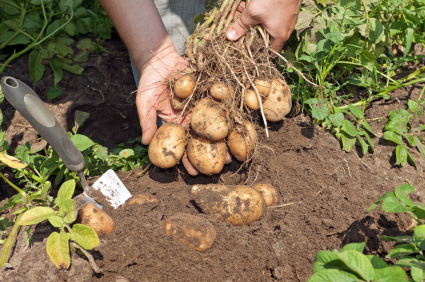
Potatoes are one of the easiest root vegetables to grow. They are extremely versatile and can be grown in almost any kind of space from moderate sized containers to large fields. There are many different potato varieties, usually categorized as early, second early, and main crop potatoes. Early types are good for small spaces and are less likely to be affected by pests. Main crops take up the most space but are usually the best type to use if you intend to store your potatoes for later use. One of the advantages of growing your own potatoes is that they can be harvested and eaten at various stages of growth.
Here are five top tips for growing your own potatoes
- Allow your seed potatoes to chit (or sprout) before planting in the ground. Chitting involves placing your seed potatoes somewhere cool and light where they can develop sturdy shoots. Place them in egg boxes, or shallow trays, and make sure any shoots are facing upwards. Leave seed potatoes to chit for a few weeks before planting.
- ‘Earth up’ your potatoes for optimum growth. ‘Earthing up’ involves placing extra soil around the base of your potato plants to help them grow better. You can also mix well-rotted compost into the soil to help retain moisture. It should be performed at 2-3 week intervals, and can be done 3-4 times throughout the growing season.
- Protect the foliage. Potato foliage can spread far and wide. This is good news if you intend to plant your crops in a spot where there are lots of weeds, as the extensive foliage on your potato plants will drown them out. Keep foliage healthy by protecting them from frost and giving them plenty of sunlight.
- Try growing your potatoes in containers. Potatoes are excellent vegetables to grow in containers if you are short on garden space. Make sure you use good quality soil, and plant in a container that is at least 35cm deep and 50cm wide. Place your container on bricks, or something similar, to ensure it has adequate drainage.
- Watch out for potato blight. Potato blight is caused by a fungus which produces an infection characterised by dark brown patches on the leaves. The infection eventually travels down to the tubers and causes them to turn slimy and rotten. To prevent the infection spreading, you should destroy any leaves and tubers showing signs of blight.
Resources:
